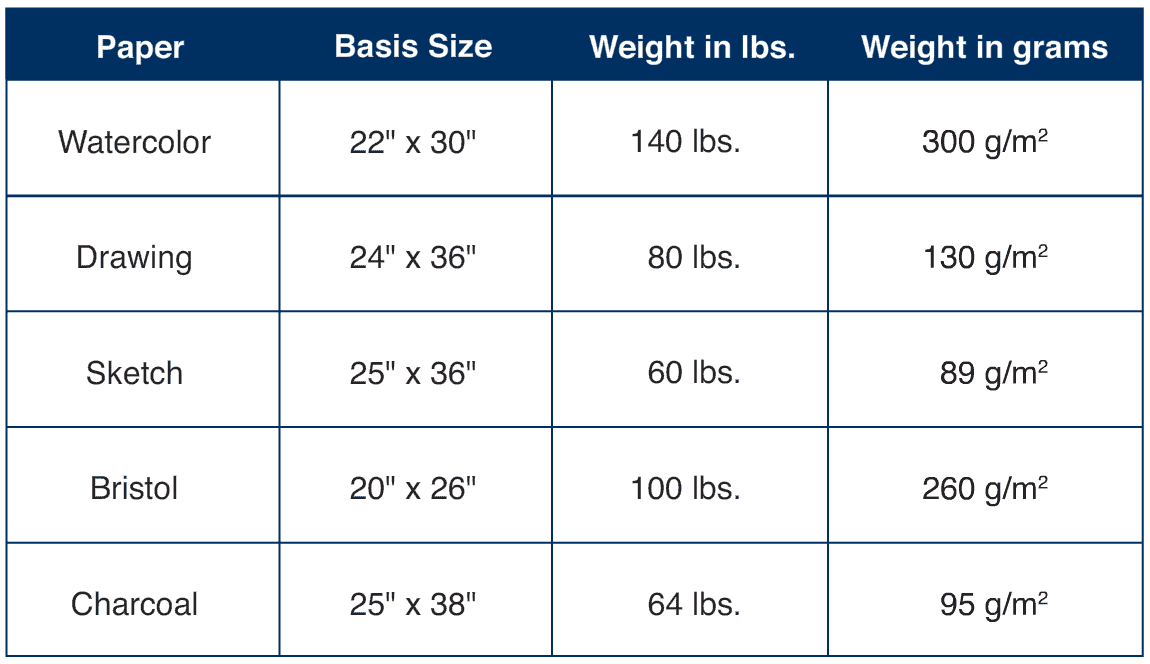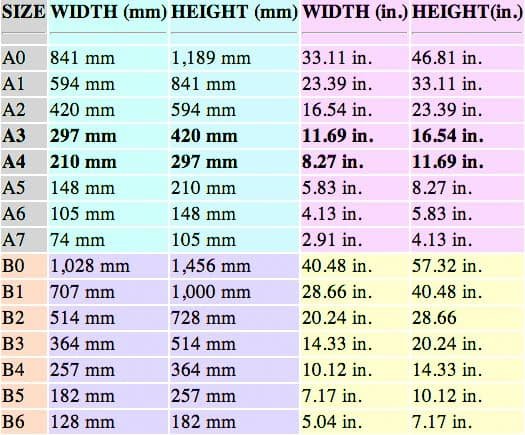We have talked a lot about various kinds of paper sizes, envelope sizes, poster sizes, newspaper sizes, and other things. Have you ever heard about Paper Weights?
Table of Contents
Paper Weights
The basic thing that relates to all of them is paper. We’ve talked about how different sizes of paper are used for different purposes. But wouldn’t you question us about quality? For home and general purposes, we always want the best quality at the lowest price available. But when using paper for business and official purposes, it is very important that the quality of paper be desirable because that helps in making an impression in the minds of the ones you’re dealing with.
Paper Quality depends mainly on the material used in making paper and the thickness of the paper. While the material used is not in our control – we just have to believe what the manufacturer says – but the thickness is.
There are papers of different thicknesses available in the market, and we can choose the thickness according to our need, but there’s a small catch. In actuality, manufacturers don’t mention the thickness of the paper. Usually, the paper’s weight or specifically gsm (grams per square meter) is stated, and one has to decide the thickness based on that. Simple math tells us that the more the gsm of a paper, the more its thickness would be if the material is the same and if the material differs, then a heavier (and possibly better) material has been used in the manufacture of that paper.
Overall, we can say that as the gsm increases, the quality gets better. But weight, is that so obvious and true? Cardboard paper has more gsm than normal paper but what about quality? And also, if we talk only about the normal paper, yes, quality gets better with increasing gsm, but so does the weight. Paper gets heavier, and this causes transportation problems. So, we must thoroughly know the Paper Weights before choosing the kind of paper we want. Let’s get into it then.
ISO 536 and the US Paper Weights
Just like other standards in ISO, Paper Weights too have been Standardized and stated in ISO 536. ISO 536 Paper Weights are used in Europe, Asia, and most parts of the world that have accepted the ISO Paper Sizes and other ISO Standards. ISO 536 uses grams per square meter (g/m² or gsm) of paper to state the weight of various papers. This is also commonly known as the Grammage of Paper.
The US and other North American Countries that have not accepted the ISO Standards continue to use the traditional method of Basis Weight of Paper or US Paper Sizes. Basis Weight is generally stated in pounds (lbs.) and is defined as the weight of an uncut paper (see Reams & Quires – Paper Quantities Explained) ream consisting of 500 sheets.
Grammage of Paper

ISO 536 has standardized the weights of various kinds of paper sizes based on thickness and the material of paper. The standard that is used to measure Paper Weights of papers having different thicknesses and made of different materials but having the same size is the gsm (grams per meter square) or g/m2, also known as the grammage of paper. Thus, this means that once the gsm or grammage of the paper and the size of the paper are fixed, the weights of all such papers with the exact same grammage, size, and thickness will be the same within error limits.
As per the ISO 216 standards, A0 Paper Size is the size that has an area of 1m2. Thus, simple mathematics tells us that all A0 Paper Sizes made of 75 gsm paper will weigh 75 grams, similarly, all A0 Paper Sizes made of 100gsm paper will weigh 100 grams; thus we can calculate the overall weight of any paper size. The formula can be stated as follows:
The weight of paper (in g)
= gsm of the paper × area of writing in m2
= gsm of the paper × length of paper in meters × breadth of paper in meters
The most commonly used term for grammage in Paper Weights is gsm; not g/m2 due to the inability of earlier computers and printers to support superscripted characters. This led to gsm becoming the standard abbreviation. The most commonly used papers are 80 gsm. We generally use 75-80 gsm papers for official purposes. However, we use higher 90-120 gsm papers for formal purposes. And lastly, 160-200 gsm papers for card paper and invitations. Newspapers generally need to be lightweight and thin for portability and are available in 45-50 gsm paperweights.
Weight of Sheets & Reams Calculator
Basis Weight

Basis Weight is a traditional system of measuring Paper Weight. People used it before introducing ISO 536 Standards for Paper Weights in Europe and America. However, they still use it in the US and other North American countries. It is the weight in pounds (lbs.) of a ream of 500 sheets of uncut paper (i.e., before the paper is cut to size). Bond, Index, and Cover Stock are some of the different types of uncut paper.
Letter and Legal Paper Sizes cut into size from the same kind of stock of uncut paper will have the same basis weight and hence 20lb. Bond Letter and 20lb. Bond Legal will have the exact same thickness even though the actual Paper Weights differ. But 28lb Bond Letter and 28lb Cover Letter will differ in thickness as the uncut stock, here, is different.
Sometimes, we use # in place of lb when mentioning basis weights. The default paper is of Bond stock. And therefore, we do not write bonds in conjugation with the basis weight as people can understand it.
However, we always mention Index Stock in conjugation with the basis weight. Most of the time, we use 20lb – 24lb papers for official purposes. 60lb – 65lb Cover, 90 lb-110 lb Index, and 90 lb-110 lb Cover for light, medium, and heavyweight card papers, respectively. The newspaper has a stock type called Newsprint of 24” × 36” in uncut size. Also, 30lb Newsprint is the most common paper for Newspapers. You can find Conversion tables for Basis Weight to Grammage Conversion here.
What’s Weight of A Sheet of Paper?
A Series Paper Sizes are available in the following gsm (grammage) Paper Weights: 75, 80, 90, 100, 110, 120, and 160 gsm. Out of these, 75gsm A10 Size has the lowest weight of 0.16 g (0.006 oz), and 160 gsm 4A0 Size weighs the most at 640 g (22.575 oz). Very heavy, isn’t it? 640 g for one sheet. Anyway, you can easily calculate the weight of all the A Series Paper Sizes in grams easily. Just use the formula that we have in the Grammage Section above. Don’t know the dimensions of A Series Paper Sizes? Check out this article: A Series Paper Sizes. You can always convert grams into ounces using 1 gram = 0.035274 ounces.
Weights of Sheets of A Series Paper Sizes in Grams
[table id=17 /]Weights Of Sheets Of A Series Paper Sizes In Ounces
[table id=18 /]FAQs
What does the paperweight serve?
A paperweight is a little solid object heavy enough to keep papers from blowing away in a breeze or moving beneath the strokes of a painting brush (as in Chinese calligraphy).
Does the weight of the paper impact the quality?
The weight of the paper stock is a determinable criterion to consider for quality. To understand how paper weight impacts printing, you must first grasp how to describe paper weight. Paper stock options have a lot of complex numbers, so consider them in terms of function.
What factors influence paperweight?
What are the various kinds of paperweights?
The diameter of most paperweights ranges from two to three and a quarter inches. Miniatures are weights with a diameter of two inches or less. Magnums are paperweights that are larger than three and a quarter inches.
What GSM paper is better?
GSM stands for grams per square meter and implies paper quality. Standard copy paper is generally 70 to 80gsm, good-grade notebook paper is typically 80 to 90gsm, and high-quality writing paper is typically 90gsm and higher.
What variables influence paper quality?
Printability differs from print quality since other printing technology considerations influence print quality. The main qualities of paper are brightness, opacity, gloss, softness, porosity, and size, but the needs vary depending on the printing technique.
How do you exhibit paperweights?
Paperweights are centerpieces in a glass bowl or an entry table mirror.
What is the paperweight?
What motivated the development of paper weights?
In the past, paperweights were luxury objects that fulfilled the 19th-century demand for decoration while being relatively inexpensive to produce. At the period, letter writing was a popular pastime, and paperweights became a trendy and cost-effective way to beautify a home while keeping papers orderly in drafty rooms.





